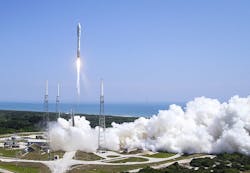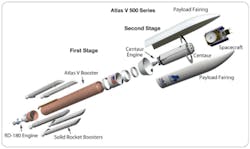United Launch Alliance wins $191M U.S. Air Force contract to launch Space Test Program-3 mission
CENTENNIAL, Colo. United Launch Alliance (ULA), a joint venture of Boeing and Lockheed Martin in Centennial, Colorado, won a contract under the U.S. Air Force's Phase 1A procurement strategy to launch the Space Test Program-3 (STP-3) mission into orbit.
The STP-3 mission is scheduled to launch in June 2019 from Space Launch Complex-41 at Cape Canaveral Air Force Station in Florida. Based on the contract, this mission will launch aboard an Atlas V 551 vehicle.
This contract marks the third competitively sourced National Security Space (NSS) launch service after more than a decade of sole-sourced contracts. The firm-fixed price, standalone contract is valued at $191,141,581 and calls for ULA to provide the Government with a total launch solution for the STP-3 payload, which includes launch vehicle production, mission integration, and launch operations and spaceflight certification.
On the cost of satellite launches ULA is set to receive approximately $1 billion in FY17 and $1.2 billion in FY18 to fund their launch operations, for a total of roughly $12 billion since 2006. This is a subsidy that no other provider receives, including SpaceX. Once this subsidy is phased out after 2019, ULA’s full burdened launch costs to the government were revealed to be $422M per mission. At the same time, industry pundits speculate that cost savings achieved through SpaceX’s reusable rocket will give the company an undeniable edge and advantage to taxpayers. In fact, competition from SpaceX reportedly has prompted ULA to reduce the price of its launches by one third. |
“The competitive award of the STP-3 Launch Services contract to United Launch Alliance directly supports SMC’s mission of delivering resilient and affordable space capabilities to our Nation,” says Lt. Gen. John F. Thompson, Air Force program executive officer for Space and SMC commander.
The STP-3 mission consists of a primary space vehicle (STPSat-6) and an integrated propulsive EELV Secondary Payload Adapter (ESPA) holding up to six payloads (IP-ESPA). The STPSat-6 space vehicle will host the National Nuclear Security Administration (NNSA), Space and Atmospheric Burst Reporting System-3 (SABRS-3) payload, and the NASA Laser Communications Relay Demonstration (LCRD) payload. Additionally, seven science and technology (S&T) payloads are manifested by the Department of Defense Space Test Program on STPSat-6.
“ULA is the choice for customers when a critical payload must be delivered to space on-time and safely,” says ULA President and CEO Tory Bruno. "We are honored that the Air Force has entrusted ULA with launching this important test mission. ULA offers the most reliable ride to space. With a mission success record of 100 percent and a tremendous heritage of 71 consecutive successful Atlas V launches, we provide the best overall launch service for our customers.”
ULA launched the first Space Test Program mission in March 2007. The launch marked the first Air Force Evolved Expendable Launch Vehicle mission on an Atlas V and the first Atlas V mission for ULA.
On SpaceX’s bid The fact that SpaceX bid for STP-3 likely meant that the U.S. Air Force got a better deal for the taxpayers. SpaceX has completed testing of two of the three Falcon Heavy boosters – the center core (a new booster) and one of the side boosters, which was previously flown during the Thaicom 8 mission – and both are now at the Cape. SpaceX expects the third to arrive in August. “The mission performance required that we bid Falcon Heavy. We did submit a bid, but with the knowledge that our first Falcon Heavy flight might occur after the time of the award. Given we have not flown Falcon Heavy, we did not anticipate winning this mission,” says John Taylor, SpaceX spokesman. |
The Phase 1A procurement strategy reintroduces competition for National Security Space launch services. The Phase 1A construct was recently extended from FY17 to FY19 to allow the development of new launch vehicles, which added six additional competitive launches for a total of 15 competitive launches. This award marks another milestone in the Air Force’s ongoing efforts to reintroduce a competitive procurement environment into the EELV program.
The Air Force Space Command's Space and Missile Systems Center, located at the Los Angeles Air Force Base, California, is the U.S. Air Force's center of excellence for acquiring and developing military space systems. Its portfolio includes the Global Positioning System, military satellite communications, defense meteorological satellites, space launch and range systems, satellite control networks, space based infrared systems, and space situational awareness capabilities.
With more than a century of combined heritage, United Launch Alliance has delivered more than 115 satellites to orbit that provide critical capabilities for troops in the field, aid meteorologists in tracking severe weather, enable personal device-based GPS navigation, and unlock the mysteries of our solar system.
Search the Aerospace & Defense Buyer's Guide
The go-to resource for Intelligent Aerospace technology news & information:
Covering key topics
Across all market segments
Subscribe to the free Intelligent Inbox e-newsletter
Subscribe to receive all the latest aerospace technology news & information, delivered directly to your e-mail inbox twice a week (Tuesdays and Thursdays). Sign upfor your free subscription to the Intelligent Inbox e-newsletter at http://www.intelligent-aerospace.com/subscribe.html.
Connect on social media
Keep pace with aerospace innovation and opportunities via your favorite social media channels. Connect with Intelligent Aerospace on Twitter (@IntelligentAero), LinkedIn,Google+, and Instagram.


